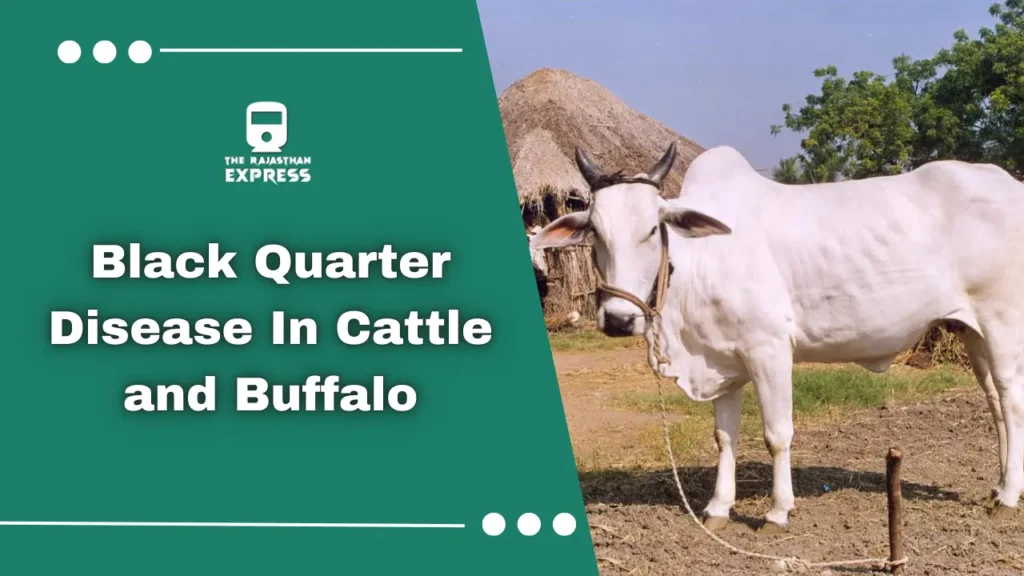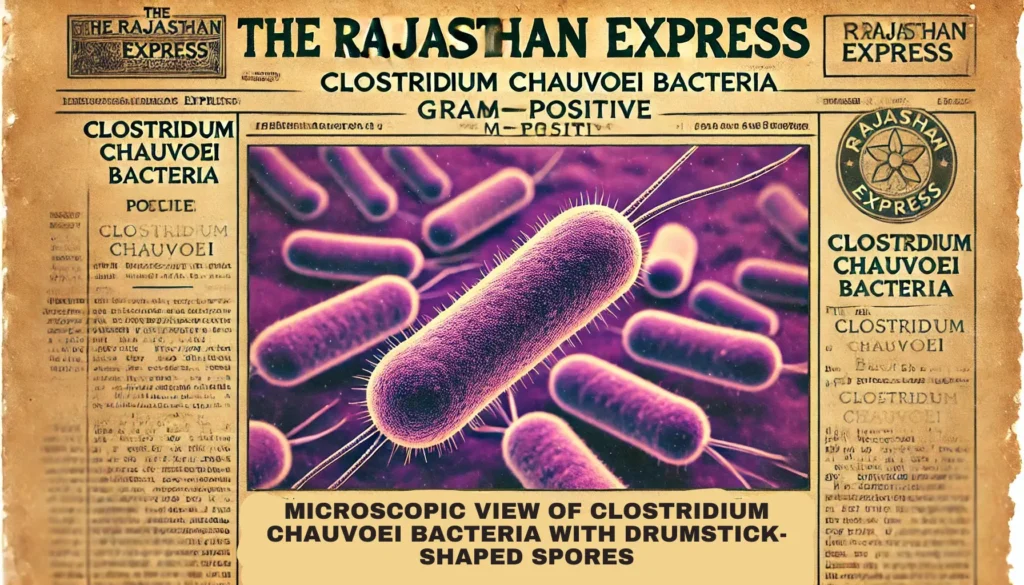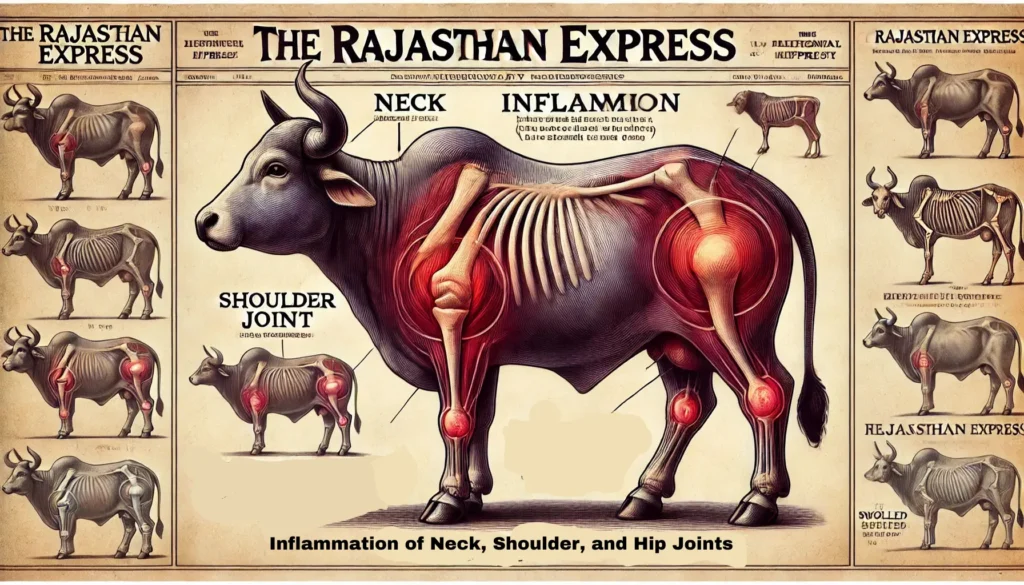What is Black Quarter Disease?
Black Quarter Disease (commonly known as Black Leg or Quarter Ill) is a bacterial disease primarily affecting cattle and buffaloes. It is characterized by gas-filled swelling in the muscles of the shoulders or thighs, accompanied by high fever and septicemia, often leading to the animal’s death.
Key Characteristics of Black Quarter Disease
- Swelling: The affected muscles, particularly the larger ones, develop gas-filled, painful swelling, medically termed as Emphysematous Swelling.
- Acute Nature: The disease usually lasts 2 to 6 days, making it an acute disease (diseases that last 3–14 days).
- Common Age Group: Black Quarter is most prevalent in cattle aged 6 months to 3 years.
- Seasonality: It spreads predominantly during the monsoon season when conditions are warm and humid.
- Species Affected: While it mainly occurs in cattle and oxen, it is less common in buffaloes, goats, and horses.

What is a synonym for black quarter?
- Black Leg
- Quarter Leg
- Quarter Ill
- Jahrabad
- Black Fever
Black Quarter Disease Information
| Common Names | Black Leg, Quarter Ill, Jahrabad, Black Fever |
|---|---|
| Scientific Name | Clostridium chauvoei Infection |
| Causing Agent | Clostridium chauvoei (Gram-positive, spore-forming bacterium) |
| Species Affected | Cattle, Buffalo, Goats, Horses |
| Age Group | 6 months to 3 years (mostly) |
| Seasonality | Predominantly during monsoon (warm, humid climate) |
| Symptoms |
|
| Treatment |
|
| Vaccination |
|
| The Rajasthan Express: Black Quarter Disease Details | |
Distribution of Black Quarter in India
The disease is enzootic (localized outbreaks) in regions like Karnataka, Andhra Pradesh, Tamil Nadu, and Rajasthan, where the climate is warm and humid.
- High-Risk Areas: Mumbai, Hyderabad, Mysore.
- Spread Pattern: If the spread rate increases, Black Quarter can transition from an enzootic disease (localized outbreaks) to an epizootic disease (widespread outbreaks).
Cause of Black Quarter Disease (Etiology)
- Bacteria: Caused by Clostridium chauvoei, a Gram-positive, spore-forming bacterium.
- Spores: The bacteria can survive for years in soil through spores, which appear like drumsticks or tennis rackets under a microscope.
- Anaerobic Nature: These bacteria are anaerobic and can thrive without oxygen.
- Disinfection: Spores can be destroyed using a 3% formalin solution.

Other Acute Diseases in Livestock
- Foot and Mouth Disease (FMD)
- Anthrax
- Rinderpest (Bovine Typhus)
- PPR (Peste des Petits Ruminants)
- PPH (Post Parturient Haemoglobinuria)
Transmission and Pathogenesis
Sources of Infection
- The bacterium resides in the environment, pastures, contaminated soil, and food.
Modes of Transmission
- Through the digestive tract when animals consume contaminated fodder.
- Through wounds or injuries on the animal’s body.
Disease Progression
- Once inside the body, the bacterium multiplies rapidly.
- It produces toxins in the muscles of heavy organs like the shoulders and hindquarters.
- These toxins cause swelling, and the affected animal may limp on one or both legs.
- Gas gangrene develops at the swollen site as tissues and cells begin to necrotize (die).
Spread Within the Body
- The bacterium produces spores that facilitate the infection’s spread to other body parts.
- Toxin dissemination throughout the body leads to septicemia, resulting in the animal’s death.
Black Quarter Disease Symptoms
- Muscle Swelling
- Swelling in the neck, shoulder joints, and hip joints causes lameness in affected animals.
- Gas Gangrene
- The muscles in the affected area decay due to Clostridium chauvoei.
- The skin in the swollen region turns brown or faded.
- Crepitant Sound
- When the affected area is pressed, a crackling sound (like crumpling paper) is heard, a key indicator of Black Quarter Disease.
- Blackish Blood
- When an incision is made at the gangrenous site, dark blackish blood oozes out.
- High Fever
- Affected animals develop high fever, leading to physical weakness.
- Difficulty Walking
- Due to fever and muscle swelling, animals limp on one or both legs, which is why the disease is called Langda Bukhar (limping fever).

Types of Gangrene:
Gangrene is a condition in which the cells and tissues of a specific body part die, leading to decay in that area. This problem occurs when the blood supply to that part of the body stops. As a result, there are noticeable changes in the color of the affected area.
1. Dry Gangrene:
- In this type, the affected part dries out and turns black.
- It usually occurs due to poor blood circulation or chronic infections.
2. Wet Gangrene:
- This type involves swelling and the formation of pus (a watery substance).
- It is more dangerous and can spread rapidly.
3. Gas Gangrene:
- Gas gangrene produces a crepitant sound (crackling) when the affected area is touched.
- On making an incision, frothy and black blood oozes out.
- It is commonly observed in Black Quarter Disease (BQ).
Symptoms of Gangrene:
- Change in color of the affected area (black, green, or blue).
- Pain, swelling, and a sensation of warmth in the affected region.
- Foul odor emanating from wounds.
Diagnosis of Black Quarter (BQ):
1. Based on Symptoms:
- The disease can be diagnosed by observing specific symptoms in the animal, such as swelling, high fever, and limping.
2. Crepitation Sound:
- When the swollen area is pressed, a crackling sound (crepitation) is heard, caused by gas gangrene.
3. Fluid Testing from the Swelling:
- Fluid extracted from the swollen area is subjected to bacterial testing, which confirms the presence of Clostridium chauvoei bacteria.
Differential Diagnosis:
Differences between Black Quarter (BQ) and Anthrax:
Anthrax:
- In Anthrax, blood oozes out from the animal’s natural openings (mouth, nose, vagina, anus).
Black Quarter (BQ):
- In BQ, making an incision on the swollen area releases frothy, black blood caused by gas gangrene.
Treatment of Black Quarter Disease:
Black Quarter disease is caused by Clostridium chauvoei bacteria, which is a gram-positive bacterium. Penicillin is the preferred antibiotic (drug of choice) for treating all gram-positive bacterial infections.
Prescription (Rx):
- Injection: Penicillin
- Administered via Intramuscular (I/M) or Intravenous (I/V) route.
Vaccination for Black Quarter Disease
Vaccination is essential for preventing diseases like Anthrax, Black Quarter (BQ), FMD, and Haemorrhagic Septicaemia. These vaccinations should ideally be administered before the monsoon season, generally during the months of May and June.
Black Quarter Vaccine for Cattle and Buffalo:
- Vaccine Name: Alum Precipitated BQ Vaccine
- Dose Rate: 5 mL, Subcutaneous (S/C)
- Primary Dose: Administered at 6 months of age
- Booster Dose / Revaccination: Annually, before the rainy season
Black Quarter Vaccine for Goat and Sheep:
- Vaccine Name: Alum Precipitated BQ Vaccine
- Dose Rate: 2.5 mL, Subcutaneous (S/C)
- Primary Dose: Administered at 6 months of age
- Booster Dose / Revaccination: Annually, before the rainy season
Black Quarter Vaccine Details
| Animal | Vaccine Name | Dose Rate | Primary Dose | Booster Dose / Revaccination |
|---|---|---|---|---|
| Cattle and Buffalo | Alum Precipitated BQ Vaccine | 5 mL, Subcutaneous (S/C) | Administered at 6 months of age | Annually, before the rainy season |
| Goat and Sheep | Alum Precipitated BQ Vaccine | 2.5 mL, Subcutaneous (S/C) | Administered at 6 months of age | Annually, before the rainy season |
| The Rajasthan Express: Your Trusted Source for Animal Health Information | ||||
What is a Vaccine?
A vaccine is a medicinal preparation administered to develop active immunity against infectious diseases. Its primary objective is to prepare the body’s immune system to protect individuals or animals from specific diseases.
History of Vaccines
- The term “vaccine” was introduced by Edward Jenner.
- The first vaccine developed was the smallpox vaccine, created by Edward Jenner in 1796 using the cowpox virus (Vaccinia Virus).
- This vaccine was used to protect humans from smallpox.
- The word “vaccine” originates from Vaccinia Virus (cowpox virus).
Basic Science of Vaccines
- Most vaccines contain antigens in an inactive form.
- These antigens trigger the immune system to develop immunity against specific diseases.
Precautions Before Vaccination
1. Check the Animal’s Health
- Ensure the animal is in good health before vaccination.
- Do not vaccinate animals that are currently sick.
2. Deworming
- Deworming should be done prior to vaccination.
3. Focus on Healthy Animals
- Vaccination should only be carried out on completely healthy animals.
4. Injection Site
- Most vaccines are administered subcutaneously (S/C) in animals.
Discover the common symptoms of Black Quarter Disease in cattle, sheep, and other animals. Early detection can save your livestock.
People Also Ask
What is Black Quarter Disease?
What is the Black Quarter Vaccine?
What is the preferred medicine for Black Quarter?
How can Black Quarter Disease be prevented?
What is Black Quarter caused by?
What are the symptoms of Black Quarter?
How is Black Quarter treated in cattle?
What is the vaccine for Black Leg?
What causes Black Quarter?
What is Black Quarter?
How does Black Quarter spread?
What is the mortality rate of Black Quarter disease?
What is another name for Black Quarter disease?
- Black Leg
- Quarter Leg
- Jahanbad
- Black Fever
- Quarter Ill
